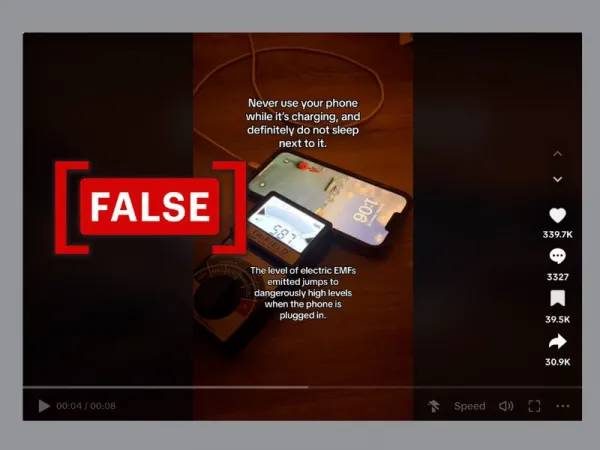By: Iryna Hnatiuk
March 20 2024
No, EMF levels in a charging phone don't rise to dangerously high levels

Viral social media post suggesting the level of EMF in a charging phone rises to dangerously high levels. (Source:TikTok/Screenshot/Modified by Logically Facts)
The Verdict False
A viral social media post suggests that it is risky to use or be near a mobile phone while charging because of the high emissions of radiation. Despite its virality, this claim is misleading and lacks a factual basis.
Context
A video (archived here) shared tens of thousands of times warns against using mobile phones while charging because "the level of electric EMFs (Electromagnetic Fields) emitted jumps to a dangerously high level when the phone is plugged in." The author also strongly recommends not sleeping near a charging phone.
In the video, an individual employs an EMF meter while a phone is plugged in. Upon connection, the indicators on the device promptly escalate to approximately 600.
In fact
By utilizing the zoom function, we can observe units of measurement displayed adjacent to the numerical indicator — V/m. The strength of the electric field is measured in volts per meter (V/m).
According to the Belgian Health, Food Chain Safety, and Environment federal public service, the safe levels of electromagnetic radiation are the following:
-
for an electric field, the limit is 5 kilovolts per metre (5000 V/m or 5 kV/m);
-
for a magnetic field, the limit is 100 microtesla (100 µT).
The indicator of the strength of the electric field is within its normal range.
The text part of the publication warns that "EMFs are linked to tumors, headaches, fatigue, insomnia, cancer, and more, so it's essential to reduce our exposure." However, there is no scientific evidence that exposure to normal EMF levels has any health effects.
Unlike high-energy (ionizing) radiation, EMFs in the non-ionizing part of the electromagnetic spectrum cannot damage DNA or cells directly. Cell phones emit a form of radiofrequency radiation at the lower end of the non-ionizing radiation spectrum. Many studies on the subject have been performed over the last two decades, and, to date, no adverse health effects have been established as being caused by mobile phone use. These studies are collected on the Electromagnetic Fields and Cancer page of the National Cancer Institute website.
The U.S. Food and Drug Administration states that "the weight of nearly 30 years of scientific evidence has not linked exposure to radio frequency energy from use of cell phones to health problems."
The Centers for Disease Control and Prevention wrote that while cell phones do use radiofrequency radiation to send signals, these are different from the ones we know can be harmful (X-rays, for example). Although long-term studies are still required, no scientific evidence currently links health issues to cell phone usage.
Andrew Wood, who chairs the Department of Health and Medical Sciences at Swinburne University of Technology in Melbourne, told AAP FactCheck that "any cable with a connection to the mains (and not connected to any appliance) would do the same. There is nothing special about the phone in this regard."
Eric Yeatman, head of Imperial College London’s Electrical and Electronic Engineering department, confirmed this to Logically Facts and added that other appliances would see a similar result. "A phone charger has a unit at the wall end that converts dangerous mains voltage to harmless low voltage DC, which travels along the lead and into your phone," he said.
The rest of the text part of the publication reads, "I use an EMF modulating device that neutralizes the harmful effects of EMFs and radiation. See the link in my bio and use code to get a discount." The profile promotes devices designed to mitigate the potential harm of EMF, which, in the case of mobile phones and other electronic devices used within homes, is deemed nonexistent.
Selling such devices is a thriving industry, according to Wired. Kenneth Foster, a bioengineering professor emeritus at the University of Pennsylvania, told the magazine, "First, there is no way for the average consumer to know how effective such a protective device is, and they would probably be wasting their money for a little reduction in exposure. Second, there is no demonstrable health benefit as long as the cell phone operates within safety limits, which all legally sold devices do."
The verdict
No scientific evidence indicates a connection between using a mobile phone while charging and health risks. The indicator on the video displays the strength of the electric field within its typical range. Therefore, we have marked this claim as false.


